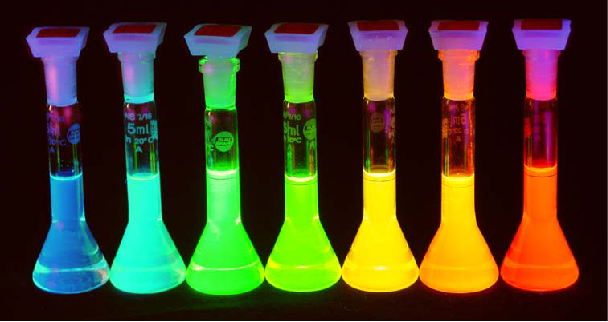Surface Chemistry: Properties of Colloids
Due to their small size, colloidal particles do not settle out of solution. Particles lying in the colloidal size range possess an enormous surface area compared with the surface area of an equal volume of larger particles. In order to compare the surface area of different systems, we use the term specific surface area (= surface area per unit weight or volume of material).The large specific surface area provides unique properties of colloidal dispersions as follows.
Optical properties:
Colloidal systems scatter the light (Tyndall effect).When a strong beam of light is passed through a colloidal sol some of the light may be absorbed, some is scattered and the remainder is transmitted undisturbed through the sample.

Fig 1: Size-dependent change of colour in Gold sol.
Colligative Properties
The magnitudes of colligative properties for colloidal solutions are comparatively lower than those obtained for true solutions. It is used for calculating the average molecular masses of the colloids.
Molecular-Kinetic properties
Brownian movement:
Liquid undergoes continuous chaotic and random motions called Brownian motion. This Brownian motion decreases by increasing in particle size or by increasing the viscosity of the medium.
Diffusion:
Particles spontaneously diffuse from the higher concentration region to a lower concentration region until the concentration of the system is uniform. Diffusion is a direct result of the Brownian movement.
Sedimentation:
The velocity v of sedimentation of spherical particles is given by Stoke’s law
v= d2 ( – o) g/ 18
d = diameter of the particles
o = density of the medium
= density of the spherical colloidal particles.
g = acceleration due to gravity.
= viscosity of the medium
If the particles are only subjected to the force of gravity, then the lower size limit of particles obeying Stoke’s equation is about 0.5 m.
Viscosity:
Viscosity is an expression to explain the resistance to the flow of a system under applied stress. Viscous liquids have greater applied force required to make it flow at a particular rate. Viscosity studies also provide information regarding the shape of the particles in solution.
Osmotic pressure:
It allows the calculation of the molecular weight of colloid
Electrical properties
Lyophobic sols carry a charge, because of which they get repelled on approaching another
particle avoiding their coagulation.
These are properties, which depend on, or are affected by the presence of a charge on the surface of a particle.
Particles dispersed in Liquid media may become charged mainly due to:
i) The surface active adsorption of a particular ionic species present in solution. This may be an ion added to the solution or, in the case of pure water, it may be the hydronium or hydroxyl ion.
ii) The charges on particles, which arise from ionization of groups (such as COOH) which may be situated at the surface of the particle. In these cases, the total charge is a function of pH.
iii) The charge on a particle surface may arise when there is a difference in dielectric constant between the particle and its dispersion medium.